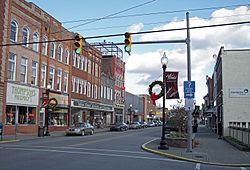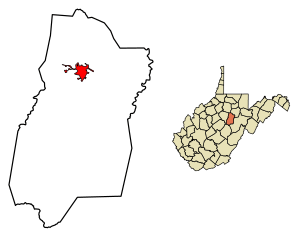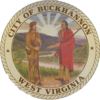Buckhannon, West Virginia facts for kids
Quick facts for kids
Buckhannon, West Virginia
|
||
|---|---|---|

East Main Street (2006)
|
||
|
||

Location in Upshur County and West Virginia
|
||
| Country | United States | |
| State | West Virginia | |
| County | Upshur | |
| Named for | Buckongahelas | |
| Area | ||
| • Total | 2.85 sq mi (7.38 km2) | |
| • Land | 2.85 sq mi (7.38 km2) | |
| • Water | 0.00 sq mi (0.00 km2) | |
| Elevation | 1,430 ft (436 m) | |
| Population
(2020)
|
||
| • Total | 5,299 | |
| • Estimate
(2021)
|
5,265 | |
| • Density | 1,893.30/sq mi (731.03/km2) | |
| Time zone | UTC-5 (Eastern (EST)) | |
| • Summer (DST) | UTC-4 (EDT) | |
| ZIP code |
26201
|
|
| Area code(s) | 304, 681 | |
| FIPS code | 54-11188 | |
| GNIS feature ID | 1536594 | |
Buckhannon is the only incorporated city in, and the county seat of, Upshur County, West Virginia, United States. Located along the Buckhannon River, the population was 5,299 as of the 2020 census. The city is 46 miles (74 km) southwest of Morgantown, 88 miles (142 km) northeast of the capital city of Charleston, and 100 miles (160 km) south of Pittsburgh, Pennsylvania. It is home to West Virginia Wesleyan College and the West Virginia Strawberry Festival, held annually during the third week of May.
Contents
History
The history of Upshur County begins with the settlement of the Buckhannon River Valley. Brothers Samuel and John Pringle were English soldiers serving in the French and Indian War (Seven Years' War) who, in 1761, deserted their post at Fort Pitt (present-day Pittsburgh, Pennsylvania). They traveled southward and upstream along the Monongahela and Tygart Valley rivers, continuing up what is now called the Buckhannon River. They were said to have arrived in present-day Upshur County in 1764 and took up living in a huge hollow of an American sycamore. They lived there for three years, living off game and fish. Finally one went out for more ammunition and found the war was over. After his return, they moved to the South Branch settlements. John later went to Kentucky, but Samuel returned to the river valley with his new wife Charity Pringle (née Cutright), her brother John Jr., friends Thomas Hughes, and John and Elizabeth Jackson with their sons George and Edward. (Edward was the grandfather of Thomas "Stonewall" Jackson.)
The City of Buckhannon was established on January 15, 1816, named after the river. Some accounts say both are named for; others that they are named after early missionary John Buchannon. The city was chartered by the Virginia General Assembly in 1852. Buckhannon was part of the Commonwealth of Virginia until the secession of West Virginia on June 20, 1863 during the American Civil War. Because of its near-central geographic location, Buckhannon was long considered a prospective site for the capital. In 1866, the legislature approved a bill including Buckhannon among the choices for capital, but officials decided the river was not wide enough to accommodate desired commerce.
The first courthouse was built in 1854. It also served as an opera house and town hall. Electricity was installed in 1891 to replace oil lamps. The building suffered fire damage in the first six months of electrical service. It was razed in 1898. In its place, a Classical Revival style courthouse, designed by Charleston architect Harrison Albright, was begun in 1899 and completed in 1901. It is still in use today. An annex of the same style was added in 1995. In the cornerstone of the main building is a time capsule filled with turn of the 19th century artifacts.
The Sago Mine Disaster, January 2, 2006, killed 12 and left one survivor. Officials said that a lightning strike in the coal caused the explosion. It was the worst mining disaster in the US since a 2001 disaster in Alabama killed 13 people, and the worst disaster in West Virginia since a 1968 incident that killed 78 people. National and international news crews were in the area for upwards of three days to cover rescue and recovery efforts.
Buckhannon takes its name from the nearby Buckhannon River. Historians believe community and river were both named for John Buchannon, a missionary to the area in the 1780s.
Geography
The city lies in the foothills of the Allegheny Mountains.
According to the United States Census Bureau, the city has a total area of 2.83 square miles (7.33 km2), all land.
Climate
The climate in this area has mild differences between highs and lows, and there is adequate rainfall year-round. According to the Köppen Climate Classification system, Buckhannon has a marine west coast climate, abbreviated "Cfb" on climate maps.
Demographics
| Historical population | |||
|---|---|---|---|
| Census | Pop. | %± | |
| 1860 | 427 | — | |
| 1870 | 475 | 11.2% | |
| 1880 | 761 | 60.2% | |
| 1890 | 1,403 | 84.4% | |
| 1900 | 1,589 | 13.3% | |
| 1910 | 2,225 | 40.0% | |
| 1920 | 3,785 | 70.1% | |
| 1930 | 4,374 | 15.6% | |
| 1940 | 4,450 | 1.7% | |
| 1950 | 6,016 | 35.2% | |
| 1960 | 6,386 | 6.2% | |
| 1970 | 7,261 | 13.7% | |
| 1980 | 6,820 | −6.1% | |
| 1990 | 5,909 | −13.4% | |
| 2000 | 5,725 | −3.1% | |
| 2010 | 5,639 | −1.5% | |
| 2020 | 5,299 | −6.0% | |
| 2021 (est.) | 5,265 | −6.6% | |
| U.S. Decennial Census | |||
2020 census
As of the 2020 census, there were 5,186 people and 2,084 households residing in the city. There were 2,431 housing units in Buckhannon. The racial makeup of the city was 90% White, 3.2% African American, 1% Asian, 0.07% Native American, 0.8% from other races, and 4.5% from two or more races. Hispanics or Latinos of any race were 2.6% of the population.
There were 2,084 households, of which 37.2% were married couples living together, 37.2% had a female householder with no spouse present, 21.8% had a male householder with no spouse present. The average household and family size was 2.97. The median age in the city was 37.8 years with 14.5% of the city's population under 18. The median income for a household in the city was $46,602 and the poverty rate was 19.5%.
2010 census
As of the census of 2010, there were 5,639 people, 2,148 households, and 1,149 families living in the city. The population density was 1,992.6 inhabitants per square mile (769.3/km2). There were 2,398 housing units at an average density of 847.3 per square mile (327.1/km2). The racial makeup of the city was 94.5% White, 2.1% African American, 0.2% Native American, 0.9% Asian, 0.4% from other races, and 1.9% from two or more races. Hispanic or Latino of any race were 2.5% of the population.
There were 2,148 households, of which 22.6% had children under the age of 18 living with them, 38.5% were married couples living together, 11.6% had a female householder with no husband present, 3.4% had a male householder with no wife present, and 46.5% were non-families. 39.9% of all households were made up of individuals, and 18.2% had someone living alone who was 65 years of age or older. The average household size was 2.13 and the average family size was 2.84.
The median age in the city was 33.1 years. 16.1% of residents were under the age of 18; 25.5% were between the ages of 18 and 24; 18.9% were from 25 to 44; 22.5% were from 45 to 64; and 17.1% were 65 years of age or older. The gender makeup of the city was 47.5% male and 52.5% female.
Education
The institutions of public primary and secondary learning serving the community of Buckhannon are operated by Upshur County Schools. West Virginia Wesleyan College is a private liberal arts college located in Buckhannon.
High schools
- Buckhannon-Upshur High School
- Fred W. Eberle Technical Center
Middle schools
- Buckhannon-Upshur Middle School
Elementary schools
- Buckhannon Academy Elementary School
- French Creek Elementary School
- Hodgesville Elementary School
- Rock Cave Elementary School
- Tennerton Elementary School
- Union Elementary School
- Washington District Elementary School
Media
There are a few radio stations and television stations located in Buckhannon. Some transmitters reach to Weston, WV, Elkins, WV, Parkersburg, WV, Morgantown, WV, Martinsburg, WV and Clay, WV.
- WBRB 101.3 FM
- WFBY 93.5 FM
- WBUC 1460 AM
- WVPW 88.9 FM
- WVWC 92.1 FM
Buckhannon is also home to a local Leased access Cable television station, Channel 3, which is available to Suddenlink cable subscribers. The station features a community bulletin board with local television advertising and events, as well as religious broadcasting and family television programming.
Buckhannon's main newspaper is the Record Delta.
Notable people
- Kyle Andrews, jazz drummer
- Stephen Coonts, American thriller and suspense novelist
- Scott Munson Cutlip, pioneer in public relations education
- Alston G. Dayton, U.S. Representative, West Virginia 2nd District
- Floyd Farnsworth (1869–1946), politician
- Charley Harper, American Modernist artist
- Olive Ireland Hodges, American missionary teacher in Japan
- Weijia Jiang, White House correspondent and morning anchor for CBS News
- Jean Lee Latham, American writer
- Pare Lorentz, pioneering documentary filmmaker, with film added to the National Film Registry
- Irene McKinney, Poet Laureate of West Virginia, appointed 1994 until her death in February 2012
- Ace Mumford, college football head football coach
- Jayne Anne Phillips, Pulitzer-Prize winning novelist and short story writer
- Kimberly A. Reed, former Chairman and President of the Export–Import Bank of the United States
- Edward Gay Rohrbough, Republican United States Representative
- Chris Wallace, general manager of the Memphis Grizzlies
In other media
- "Ballet for a Girl in Buchannon" (song cycle by Chicago from their 1970 album Chicago II; writer James Pankow misspelled the town name)
See also
 In Spanish: Buckhannon para niños
In Spanish: Buckhannon para niños



